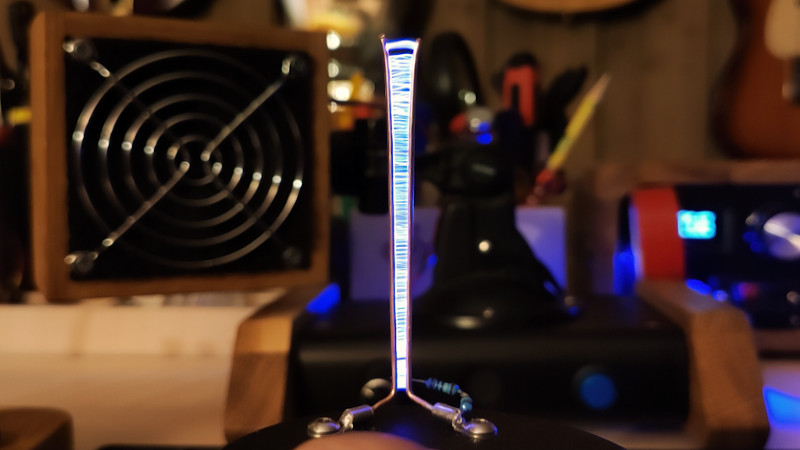Big fizzing electrical arcs are fun, and handled properly, not too dangerous either. The Jacob’s Ladder is one such piece of arc-generating equipment, one that featured heavily in vintage sci-fi films. It remains a charming demonstration of high-voltage electrical principles, and you can easily build your own mini version at home.
The build starts with a basic high-voltage step-up kit that turns 4V DC into 15 kV at the output. At this voltage level, it’s possible to generate an arc in air. To create the Jacob’s ladder, the kit is wired up to a pair of closely-spaced electrodes that slowly get farther apart as they go up vertically. When an arc jumps from one electrode to the other, it ionises the air, and the voltage sags due to the current flow. The flowing current heats up the air, which begins to rise, taking the current path with it, causing the familiar climbing arc we all know and love. As the distance between the electrodes increases towards the top, the arc can eventually no longer be sustained. With no current flowing, the voltage rises again, and a new arc forms at the bottom of the device, repeating the process.
It’s a fun build that would make an excellent desk toy, albeit best shown under glass to avoid accidental electric shocks. You can even build a larger one out of microwave parts if you’re so inclined. Video after the break.















NPN triode :D
Back in the 1950s, a transistor was commonly referred to as a “crystal triode” before the new name became the standard (e.g. see https://ieeexplore.ieee.org/document/5258847). In China, it’s simply that the 1950’s language sticks forever, and all transistors, mainly bipolar ones, are still colloquially known as (crystal/semiconductor) triodes by most technicians. Just like how a diode has vacuum and crystal versions in English terminology. If you see “NPN triodes” on AliExpress, that’s why.
But the more hilarious fact is that some clueless vendors that don’t know much about electronics will even name a 3-terminal voltage regulator as a “triode”.
Thanks, learned about using a “Gabriel electrode” ( ref: http://bigclive.com/jacobs.htm ), a very neat trick.
I’ve been using one on my ‘big’ ladder for ages. I found a nice HV rated 10Mohm resistor in an old CRT TV that works great.
Interestingly with high power arcs you can see the conductive path wrapped in some less conductive but still incandescent air: https://www.youtube.com/watch?v=hQ78fMGxj_0
Seen it a few times on simulated lightning arcs too. With the larger magnetic fields the plasma loops occasionally wizz off the side. But without any magical power source they vanish in pretty short order. So while it could be described as short lived doughnut lightning, it’s certainly not ball lightning.
Interesting.
Incidentally some researchers made progress on ball lightning.
It seems that the “Navigator” aka long duration sort may be distinct from the normal type, and possibly not even fully electrical though has its origins in regular BL.
Its possible that it might be the very first example of room-temperature superconductivity in nature, in that a natural BL happens to pass close to a structure with elemental carbon and trace elements, picks up fine particles which then hold the BL together in a quasi-superconducting plasma macro-object until either (a) it disrupts explosively or (b) runs out of energy and fizzles out dropping the particles in the general vicinity.
This also explains how multiple BL’s can appear near each other.
Tigger can make ball lightning as Tigger’s can do anything. Bounce!
It is also possible that I’m not Tigger and separately possible that ball lightning is BS.
Hmm, and room temperature super conductivity depends on the temperature of the room. Perhaps it’ll be possible one day, certainly nobody knows. However, lightning is not room temperature, it’s really, really, really, really hot.
I used to pieces of iron rod and fastened them to the top of a oil burner transformer I pulled out of the trash. https://www.youtube.com/watch?v=7w4yb-zyl18
I like the construction of his accessories on the bench, the work platform and matching PSU case and extraction fan.
Hmmmm a mini. When I was 17 I built one with a neon sign transformer I found and ran the ladder up the back of my bedroom door. Arc a gap of 3 or 4 inches. Just one of several dangerous foolish endeavors that I survived. Did someone say ozone?
Nice to see my project here ;)
Less music, more Bzzzzt!
Silicon Chip (.au electronics magazine) did a good one a few years ago that used an automotive ignition coil. You can still buy the kit: https://www.jaycar.com.au/jacobs-ladder-mk3/p/KC5520
My students built one for a class demo in 2018. We put it in a laser-cut acrylic case for safety (and to look cool!) Not only was it a fun demo, it was also useful to demonstrate RF interference and introduce electromagnetism.